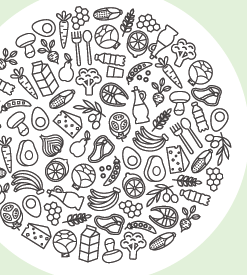A BALANCED DIET
Nutrients are substances in food necessary for good health. Unlike plants, our bodies cannot make nutrients. We get them from the food we eat. There are more than 40 nutrients and they have different functions. We can categorize them as carbohydrates, fats, proteins, vitamins, and minerals.
Carbohydrates are the body’s main source of energy. They are either simple, called sugar, or complex, called starches. We can get thesecarbohydrates from cereals, rice, potatoes, bread, pasta, fruits and vegetables. Our bodies need them to use fats effectively. Our brain also needs them. Our brains cannot work properly without the right amount of carbohydrates. This amount is equal to 1/3 pound (150grams) of sugar per day. 40% of our diet should include carbohydrates.
Fats are divided into two kinds; saturated (which are solid at room temperature) and unsaturated (which are liquid at room temperature). Saturated fats can be found in butter, cheese, milk, cream and chocolate. Nuts, oils and fish like tuna contain unsaturated fats. Many people think that fats are totally bad for us, but we need them. Fats transport, i.e., carry nutrients and they are part of some body cells. They keep us warm and active because they are a great source of energy. With their help, we can store Vitamins A, D, E and K. But do we need a lot of them? No, we don’t. Additionally, the body has very little need for any saturated fat. To be healthy, limit the amount to 10% of your diet.
Protein is the second most plentiful substance in our body. The first is water. Almost 20% of our weight is protein. Our muscles, hair, nails, skin and eyes are almost totally protein. It is essential because it builds and repairs the body cells. Foods high in protein are eggs, milk, soya beans, rice, meat, fish, corn and peanuts. Protein should make up about 20% of your daily diet.
Vitamins are necessary for many different body processes. The body needs them in small amounts to regulate, or control, internal chemical reactions. They do not provide energy, but they help the body to use the energy from foods. Each vitamin has its own function, so one cannot replace another. To give an example, Vitamin A is necessary for healthy skin and good eyesight while Vitamin C increases our body’s resistance to getting a cold.
Minerals, like vitamins, are vital for internal chemical reactions and they form body structures. For instance, calcium from milk, cheese and yogurt helps build and maintain (keep in good condition) strong bones and teeth. We get iron and zinc from meat, vegetables, fruits, bread and cereals. Hemoglobin (a substance which carries oxygen to cells) needs iron. Magnesium, for example, is necessary for a strong nervous system. Milk, vegetables, fruits, bread and cereals contain this mineral. Vitamins and minerals together should make up about 30% of your diet.

